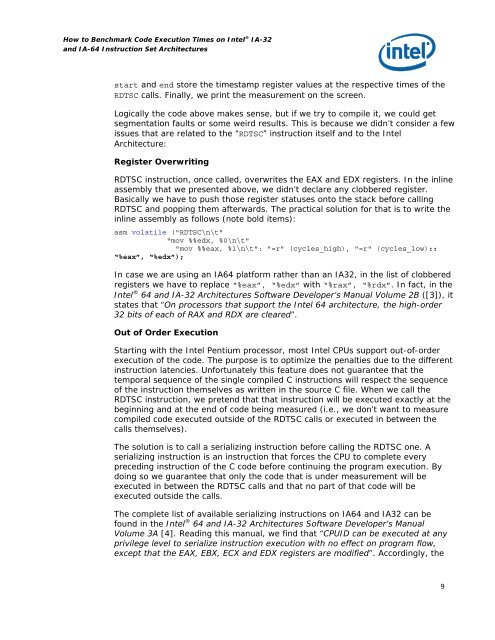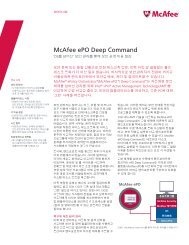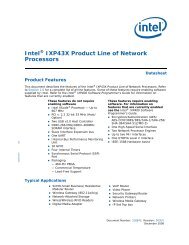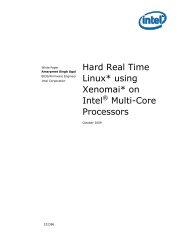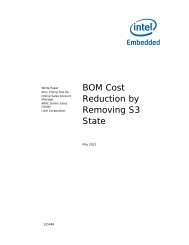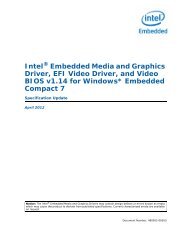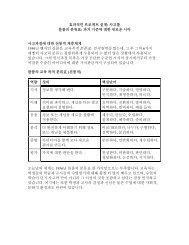How to Benchmark Code Execution Times on Intel IA-32 and IA-64 ...
How to Benchmark Code Execution Times on Intel IA-32 and IA-64 ...
How to Benchmark Code Execution Times on Intel IA-32 and IA-64 ...
You also want an ePaper? Increase the reach of your titles
YUMPU automatically turns print PDFs into web optimized ePapers that Google loves.
<str<strong>on</strong>g>How</str<strong>on</strong>g> <str<strong>on</strong>g>to</str<strong>on</strong>g> <str<strong>on</strong>g>Benchmark</str<strong>on</strong>g> <str<strong>on</strong>g>Code</str<strong>on</strong>g> <str<strong>on</strong>g>Executi<strong>on</strong></str<strong>on</strong>g> <str<strong>on</strong>g>Times</str<strong>on</strong>g> <strong>on</strong> <strong>Intel</strong> ® <strong>IA</strong>-<strong>32</strong><br />
<strong>and</strong> <strong>IA</strong>-<strong>64</strong> Instructi<strong>on</strong> Set Architectures<br />
start <strong>and</strong> end s<str<strong>on</strong>g>to</str<strong>on</strong>g>re the timestamp register values at the respective times of the<br />
RDTSC calls. Finally, we print the measurement <strong>on</strong> the screen.<br />
Logically the code above makes sense, but if we try <str<strong>on</strong>g>to</str<strong>on</strong>g> compile it, we could get<br />
segmentati<strong>on</strong> faults or some weird results. This is because we didn’t c<strong>on</strong>sider a few<br />
issues that are related <str<strong>on</strong>g>to</str<strong>on</strong>g> the “RDTSC” instructi<strong>on</strong> itself <strong>and</strong> <str<strong>on</strong>g>to</str<strong>on</strong>g> the <strong>Intel</strong><br />
Architecture:<br />
Register Overwriting<br />
RDTSC instructi<strong>on</strong>, <strong>on</strong>ce called, overwrites the EAX <strong>and</strong> EDX registers. In the inline<br />
assembly that we presented above, we didn’t declare any clobbered register.<br />
Basically we have <str<strong>on</strong>g>to</str<strong>on</strong>g> push those register statuses <strong>on</strong><str<strong>on</strong>g>to</str<strong>on</strong>g> the stack before calling<br />
RDTSC <strong>and</strong> popping them afterwards. The practical soluti<strong>on</strong> for that is <str<strong>on</strong>g>to</str<strong>on</strong>g> write the<br />
inline assembly as follows (note bold items):<br />
asm volatile ("RDTSC\n\t"<br />
"mov %%edx, %0\n\t"<br />
"mov %%eax, %1\n\t": "=r" (cycles_high), "=r" (cycles_low)::<br />
“%eax”, “%edx”);<br />
In case we are using an <strong>IA</strong><strong>64</strong> platform rather than an <strong>IA</strong><strong>32</strong>, in the list of clobbered<br />
registers we have <str<strong>on</strong>g>to</str<strong>on</strong>g> replace “%eax”, “%edx” with “%rax”, “%rdx”. In fact, in the<br />
<strong>Intel</strong> ® <strong>64</strong> <strong>and</strong> <strong>IA</strong>-<strong>32</strong> Architectures Software Developer’s Manual Volume 2B ([3]), it<br />
states that “On processors that support the <strong>Intel</strong> <strong>64</strong> architecture, the high-order<br />
<strong>32</strong> bits of each of RAX <strong>and</strong> RDX are cleared”.<br />
Out of Order <str<strong>on</strong>g>Executi<strong>on</strong></str<strong>on</strong>g><br />
Starting with the <strong>Intel</strong> Pentium processor, most <strong>Intel</strong> CPUs support out-of-order<br />
executi<strong>on</strong> of the code. The purpose is <str<strong>on</strong>g>to</str<strong>on</strong>g> optimize the penalties due <str<strong>on</strong>g>to</str<strong>on</strong>g> the different<br />
instructi<strong>on</strong> latencies. Unfortunately this feature does not guarantee that the<br />
temporal sequence of the single compiled C instructi<strong>on</strong>s will respect the sequence<br />
of the instructi<strong>on</strong> themselves as written in the source C file. When we call the<br />
RDTSC instructi<strong>on</strong>, we pretend that that instructi<strong>on</strong> will be executed exactly at the<br />
beginning <strong>and</strong> at the end of code being measured (i.e., we d<strong>on</strong>’t want <str<strong>on</strong>g>to</str<strong>on</strong>g> measure<br />
compiled code executed outside of the RDTSC calls or executed in between the<br />
calls themselves).<br />
The soluti<strong>on</strong> is <str<strong>on</strong>g>to</str<strong>on</strong>g> call a serializing instructi<strong>on</strong> before calling the RDTSC <strong>on</strong>e. A<br />
serializing instructi<strong>on</strong> is an instructi<strong>on</strong> that forces the CPU <str<strong>on</strong>g>to</str<strong>on</strong>g> complete every<br />
preceding instructi<strong>on</strong> of the C code before c<strong>on</strong>tinuing the program executi<strong>on</strong>. By<br />
doing so we guarantee that <strong>on</strong>ly the code that is under measurement will be<br />
executed in between the RDTSC calls <strong>and</strong> that no part of that code will be<br />
executed outside the calls.<br />
The complete list of available serializing instructi<strong>on</strong>s <strong>on</strong> <strong>IA</strong><strong>64</strong> <strong>and</strong> <strong>IA</strong><strong>32</strong> can be<br />
found in the <strong>Intel</strong> ® <strong>64</strong> <strong>and</strong> <strong>IA</strong>-<strong>32</strong> Architectures Software Developer’s Manual<br />
Volume 3A [4]. Reading this manual, we find that “CPUID can be executed at any<br />
privilege level <str<strong>on</strong>g>to</str<strong>on</strong>g> serialize instructi<strong>on</strong> executi<strong>on</strong> with no effect <strong>on</strong> program flow,<br />
except that the EAX, EBX, ECX <strong>and</strong> EDX registers are modified”. Accordingly, the<br />
9


